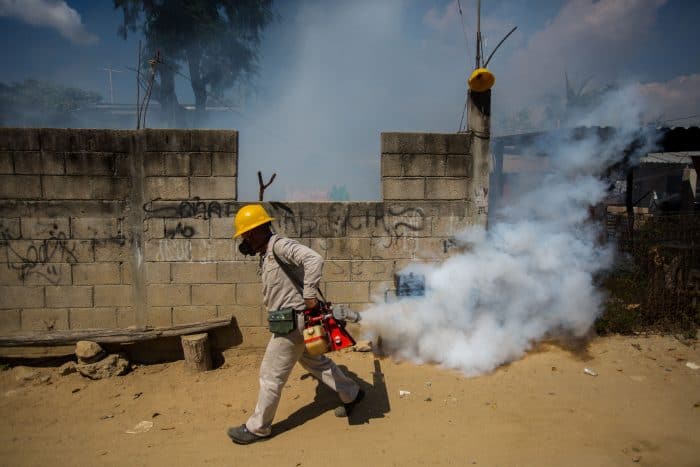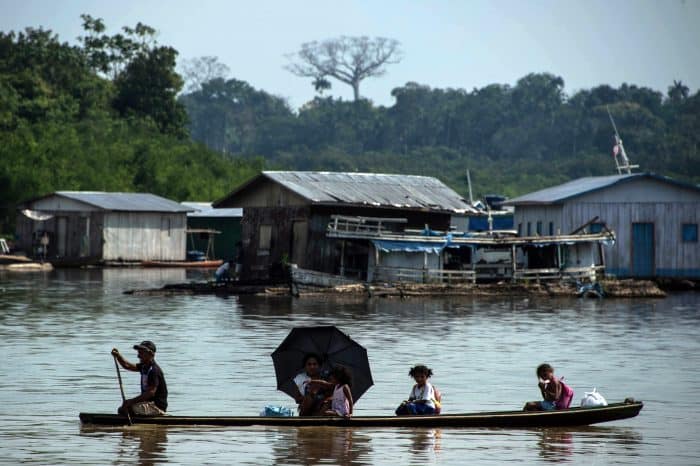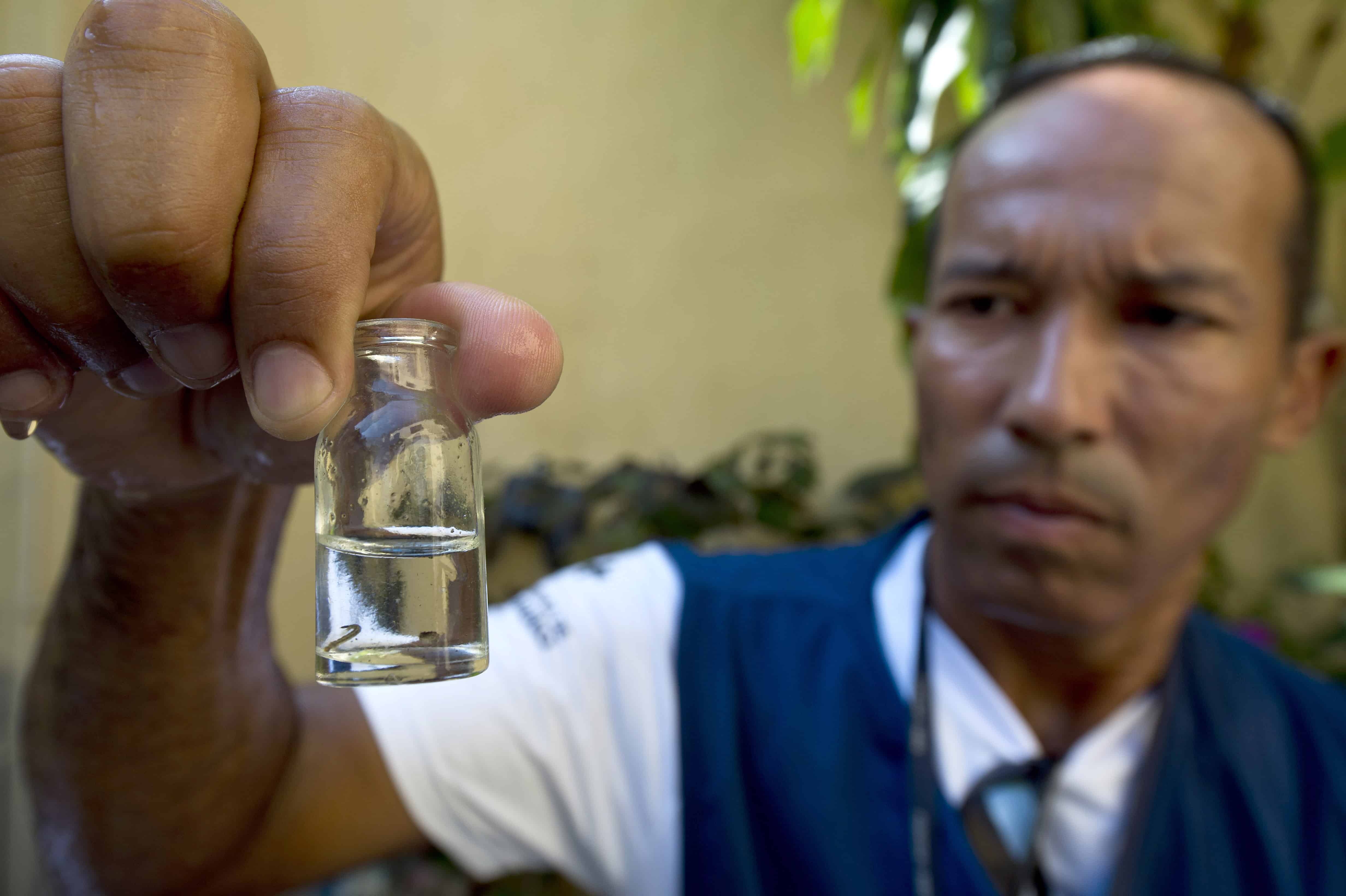The alarming spread of the Zika virus – caused in major part by the infamous Aedes aegypti mosquito, which can also carry dengue, yellow fever and chikungunya virus – is looking more and more like a public health catastrophe. But it’s also, say experts, something else: The latest example of how human alterations to their environments, in the broadest sense, can empower disease-carrying organisms such as Aedes and the viruses they bring with them.
That mosquito, in particular, thrives in “artificially human-made habitats,” says Durland Fish, a professor of microbial diseases and also forestry and environmental studies at Yale University. “Tires and cans and plastic containers and rain barrels, and things like that.”
“It doesn’t live in the ground, or in swamps, or any other kinds of places where you would normally find mosquitoes,” Fish continues. “So humans have created an environment for it to proliferate, by having all of these water containing containers around, and the mosquito has adapted so well … it’s really kind of a human parasite. It’s like the cockroach of the mosquito world.”
And unfortunately, what’s true of Aedes aegypti is true of many other disease vectors, and many other diseases – a major problem that Fish says the world still isn’t really grappling with.
That’s not to say that other factors – such as poverty, globalization, and advanced transportation systems that can carry not only people but also diseases and their vectors – aren’t equally important. But researchers such as Fish suggest that environmental factors have been neglected and, with no vaccine available for the Zika virus, are also a key part of the solution. So let’s examine some of the major ways that human-caused environmental changes have been shown to worsen the spread of diseases – before examining why more isn’t being done about the Zika virus problem:
Urbanization and urban waste
First, let’s start with the current Zika virus situation and its cause. You can make the case that the Aedes mosquito has been thriving thanks to “environmental degradation” in key areas in Brazil and other countries, says Peter Hotez, dean of the National School of Tropical Medicine at Baylor College of Medicine.
“You see not only poverty, but the environmental degradation, uncollected garbage, discarded tires filled with water, areas of un-drained water,” he says. These create habitats for mosquitoes, which then spread deadly viruses.
As Hotez’s words suggest, it can be difficult to disentangle urban growth and waste from other factors, such as poverty. But Fish argues that while Zika does primarily affect the poor, “even people who are wealthy, and live in different kinds of communities, these mosquitoes still can occur in those areas, in flower pot bases, and ornamental plants. They’re not totally immune, but not as hard hit as people in the poor areas of town.”
“There are many other factors that have contributed to the emergence [of Zika virus], but the principal drivers have been human population growth, unplanned urban growth, globalization and lack of effective vector control,” adds Duane Gubler, the founding director of the Signature Research Program in Emerging Infectious Disease at the Duke-NUS Graduate Medical School in Singapore.
See: Costa Rica’s inclusion in Zika travel warning has tourism leaders worried

This is not, of course, the first time that urbanization and city planning have been connected with disease transmission. That particular story goes at least back to 1854, when John Snow, studying a cholera outbreak in London, found that it was linked to the dumping of sewage into the Thames river and then drawing on Thames water for people to drink.
Zika may be primarily a story about how certain kinds of urban environments and urban waste empower mosquitoes, but what’s striking is how many other kinds of environmental changes have also been shown to make disease vectors worse:
Building dams
One of the most consequential things humans can do to the environment is damming a large river so that it can be used for hydropower or to create reservoirs. There have been many complaints about how dams can damage ecosystems, but there is also considerable evidence that the way they change watery environments can foster vector-borne disease.
“Dam building is one of the biggest factors in the emergence of schistosomiasis, the dam on the Upper Volta promoted the massive emergence of schistosomiasis in Ghana,” says Hotez. Schistosomiasis is a devastating disease spread by parasite-carrying freshwater snails to humans who swim in tainted water. Dams and other water management projects can make it worse because they can bring people and these snails together.
“Water impoundments of all sizes, including man-made lakes and irrigation systems, provide excellent habitats for freshwater snails and encourage close and frequent contact between people and infected water,” says a report on snail-borne diseases by the World Health Organization.
Schistosomiasis is a devastating disease, but even worse is malaria – which can also be worsened by major dam projects. Recent research suggests that dams in sub-Saharan Africa are responsible for “at least 1.1 million new malaria cases in Africa every year,” the Post’s Joby Warrick reported last year. That’s because water impounded by dams can create habitats for malaria-transmitting mosquitoes.
Or take yet another example. In the Senegal River basin of West Africa in 1987, a major epidemic of Rift Valley fever occurred. The cause? “A series of ecological modifications to the Senegal River were instituted by the Mauritanian and Senegalese governments in cooperation with internationally sponsored programs,” including two dams, reported Kenneth J. Linthicum of the U.S. Department of Agriculture’s Center for Medical, Agricultural, and Veterinary Entomology and a group of colleagues.
One of the dams led to “extensive flooding and vegetation growth” and researchers then observed humans cultivating rice in the same place that large numbers of Culex mosquitoes were spawning. The researchers conclude that it’s a classic case of how “landscape modification can contribute to endemism of diseases.”

Chopping down forests
And just as it goes for dams, so chopping or burning down forests has also been widely implicated in increasing disease transmission to humans.
Our own Chelsea Harvey reported recently on how deforestation seems to be another key enabler of malaria transmission in Malaysia, where it has brought humans and macaques into closer proximity, allowing mosquitoes to become a go-between and transfer the disease.
And that’s just one example of how chopping down trees can worsen the spread of disease. “Deforestation has been a huge issue in the emergence of disease. It promoted Ebola in West Africa. It promoted Nipah and SARS in South Asia,” says Hotez.
In Africa, where malaria is most devastating, deforestation is yet again involved. For instance, deforested areas tend to be hotter, because they lack the cooling influence of trees, and those warmer temperatures can affect key parts of the mosquito life cycle. Thus, report Jonathan Patz and Sarah Olson of the University of Wisconsin, the blood-feeding and egg laying cycle of female Anopheles gambiae mosquitoes (the deadly vector in this case) in Kenya was found to be as much as 52 percent shorter in deforested areas.
“Deforestation and cultivation of natural swamps in the African highlands creates conditions favourable for the survival of An. gambiae larvae, making an analysis of the effects of land-use change on local climate, habitat, and biodiversity key to any malaria-risk assessments,” the authors conclude.
Warming the planet
And then, well, there’s climate change. This is where we mess with the globe’s average temperatures, and thereby potentially change the comfortable ranges of vast numbers of species – including insect vectors of disease.
It stands to reason that diseases of the tropics, such as malaria and dengue and yellow fever, will be more able to penetrate out of the tropics if we shift the climate to make temperate latitudes hotter. “Globally, temperature increases of 2-3ºC would increase the number of people who, in climatic terms, are at risk of malaria by around 3- 5%, i.e. several hundred million,” concludes the WHO. “Further, the seasonal duration of malaria would increase in many currently endemic areas.”
Aedes aegypti, and all the diseases that it brings, are also expected to thrive in a warmer climate. “Dengue mosquitoes reproduce more quickly and bite more frequently at higher temperatures,” says WHO. And then there’s the Asian tiger mosquito, Aedes albopictus, which is also a threat for transmission of dengue, Zika virus and other diseases.
Aedes albopictus has already expanded into much of the United States and as a recent study by a group of U.S. mosquito control researchers at several state agencies and Rutgers University found, climate change should worsen that spread:
The land area with environmental conditions suitable for Ae. albopictus populations is expected to increase from the current 5% to 16% in the next two decades and to 43%-49% by the end of the century. Presently, about one-third of the total human population of 55 million in northeastern USA reside in urban areas where Ae. albopictus is present. This number is predicted to double to about 60% by the end of the century, encompassing all major urban centers and placing over 30 million people under the threat of dense Ae. albopictus infestations.

What we can do
It’s crucial to emphasize that while environmental factors are clearly implicated in the spread of these diseases, they aren’t the only ones.
“The big four are poverty, conflict, human migrations, and environmental factors. And most of those environmental factors are probably man-made,” says Peter Hotez.
As Hotez notes, human migrations – especially in aircraft and ships – are also responsible for helping to spread diseases and also their vectors all around the world. Aedes aegypti originated in Africa. Aedes albopictus was originally from Asia. Now they’re both all over the place. If you count species introductions into new places as another form of human-caused environmental assault (and there are good grounds for doing so) then this may be the most devastating of all from a disease standpoint.
So what can we do? Yale’s Durland Fish argues that we have to pay much more attention to how large projects involving forests, dams, wetlands and more change the ecology of diseases by changing the habitats of their vectors. And that we need to think about diseases from a much more ecological standpoint in general.
“You should be able to understand how these simple man-made aquatic habitats, how do they produce mosquitoes, what are the biological processes involved, in turning a mosquito egg into an adult mosquito,” he says of Aedes aegypti. “And we don’t understand that process.” Fish says the medical world tends to pursue cures such as vaccines, rather than ecological understanding that can lead to better prevention.
When it comes to Zika virus, says Fish, “You have to do something about the mosquitoes, and that’s strictly an environmental problem, there’s no medical applications to that. And focusing on that as an environmental issue is going to have the greatest impact on protecting people.”
© 2016, The Washington Post






